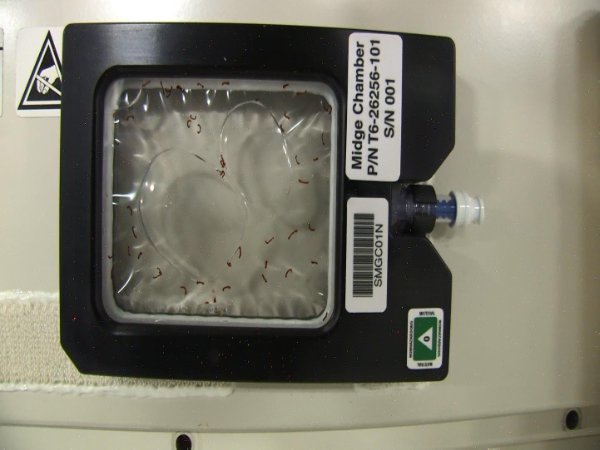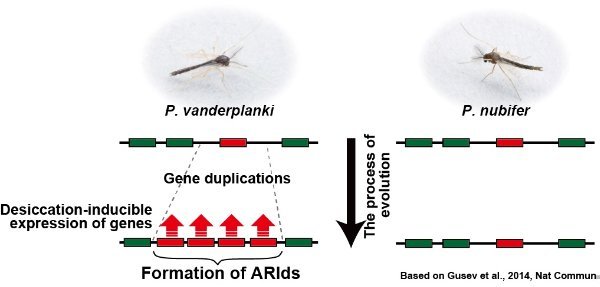On September 11, Nature Communications published a new collaborative research of Russian and Japanese scientists - Comparative genome sequencing reveals genomic signature of extreme desiccation tolerance in the anhydrobiotic midge.
We asked Oleg Gusev, one of the authors, a research associate of the KFU Extreme Biology Laboratory, to tell about the results of the comparative analysis on two species of African midge.
- Our congratulations with the article! We hope it is just the beginning for your lab. So from your point of view, what exactly interested the editors of Nature Communications in your work?
- It was a unique large project on the insect genome, aimed to understand the mechanisms of how a certain species behave in the conditions of total lack of water. We presented the results of several years of research.
- Do you mean the study of dehydrated midges used in the international space experiment?
- Exactly. The midge, Polypedilum vanderplanki, is capable of anhydrobiosis, a unique state that allows an organism to survive without water and in other severe conditions such as extreme temperatures, high doses of radiation and vacuums, including that of the space.
In the very beginning, our Russian-Japanese research team that included experts from Kazan Federal University, the National Institute of Agrobiological Sciences (Japan), Okinawa Institute of Science and Technology, Lomonosov Moscow State University, Institute of Physical Chemical Medicine and other universities, was interested in a molecular mechanism allowing single midge's cells adapt to the total lack of water.
- What is extremely new in your research and what results have you received?
- For the first time ever we have taken Polypedilum vanderplanki (able to survive without water) and one of its closer relatives, Polypedilum nubifer (that does not have such a unique feature) for comparative analysis.
First of all, we have discovered that their genome is the smallest among all the insects –one third less than the one of Belgica Antarctica. It is 15% less than that of the midge announced the one with the smallest genome just a month before.
Secondly, ordinary midges do not have any special genes, whereas a cryptobiotic midge possesses unique gene clusters connected with anhydrobiosis. It is surprising that besides ordinary protecting genes African midge has an additional group of antioxidants, special proteins and other genes whose activity is closely connected with anhydrobiosis periods.
 We have also found out that these supergenes do not exist in any other insect and their origin is caused by the horizontal transgenesis from bacteria and/or other organisms.
We have also found out that these supergenes do not exist in any other insect and their origin is caused by the horizontal transgenesis from bacteria and/or other organisms.
– Where did you conduct the research?
- The major part of the gene sequencing and studying of gene activity was held in Russia, at the Laboratory of Evolutionary Genomics of the faculty of Bioengineering and Bioinformatics, Moscow State University.
- What other researches do you plan at the Extreme Biology Lab in the nearest future?
- Having finished with the African midge, we are approaching another stage – biomimetics, when all the received knowledge is applied to biomedicine and biotechnologies.
We have just received good news that our applications for two new projects are supported by the Russian Foundation for Basic Research and the Federal Target Programme of the Russian Ministry of Education and Science. Both projects are joint research with the Institute of Agrobiological Sciences and RIKEN Centre.
The Russian Foundation for Basic Research has allocated money for the detailed analysis of genes activity in various midge's tissues and the culture of its embryonic cells. At the Functional Genomics Lab that we are establishing in partnership with RIKEN, we are going to develop an atlas of promoter expression in the midge's genome, especially to detect special types of RNA controlling the activation of cryptobiosis.
The second project focuses on how to transfer the most sensitive to dehydration parts of genome to biotechnologies. Based on genetic constructions, we are developing the methodology of synthesis and further storage of fusion proteins without loss of their biological activity in the insect's dehydrated cells.
It is unique how the genome of an insect develops so rapidly. As it is clear from the previous research, it is connected with the insect's reaction to the DNA damage (as a result of high dose of radiation), when the DNA damage do not cause the cell's death. The midge's cells repair DNA and keep on living.
The grants are a kind of academic deposit and we should prove that we are worth it.
By the way, in late October we organize the first international seminar “Life of Genomes” and PostGenome International Conference and are glad to invite everybody to these events.
– Thank you for your time! And good luck in further researches!!